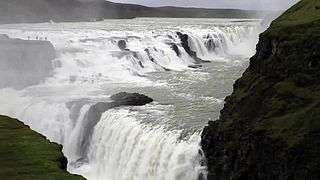Gullfoss
| Gullfoss | |
|---|---|
|
Gullfoss, an iconic waterfall of Iceland | |
| Location | Southwest Iceland |
| Coordinates | 64°19′34″N 20°07′16″W / 64.32611°N 20.12111°WCoordinates: 64°19′34″N 20°07′16″W / 64.32611°N 20.12111°W |
| Type | Tiered, Cataract |
| Total height | 32 m |
| Number of drops | 2 |
| Longest drop | 21 m |
| Watercourse | Hvítá |
| Average flow rate | 140 m3/s |
Gullfoss ("Golden Falls"; ![]() Icelandic pronunciation ) is a waterfall located in the canyon of the Hvítá river in southwest Iceland.
Icelandic pronunciation ) is a waterfall located in the canyon of the Hvítá river in southwest Iceland.
Gullfoss is one of the most popular tourist attractions in Iceland. The wide Hvítá rushes southward, and about a kilometre above the falls it turns sharply to the right and flows down into a wide curved three-step "staircase" and then abruptly plunges in two stages (11 metres or 36 feet, and 21 metres or 69 feet) into a crevice 32 metres (105 ft) deep. The crevice, about 20 metres (66 ft) wide and 2.5 kilometres (1.6 mi) in length, extends perpendicular to the flow of the river. The average amount of water running down the waterfall is 140 cubic metres (4,900 cu ft) per second in the summer and 80 cubic metres (2,800 cu ft) per second in the winter. The highest flood measured was 2,000 cubic metres (71,000 cu ft) per second.
As one first approaches the falls, the edge is obscured from view, so that it appears that the river simply vanishes into the earth.
During the first half of the 20th century and some years into the late 20th century, there was much speculation about using Gullfoss to generate electricity. During this period, the waterfall was rented indirectly by its owners, Tómas Tómasson and Halldór Halldórsson, to foreign investors. However, the investors' attempts were unsuccessful, partly due to lack of money. The waterfall was later sold to the state of Iceland, and is now protected.
Sigríður Tómasdóttir, the daughter of Tómas Tómasson, was determined to preserve the waterfall's condition and even threatened to throw herself down. Although it is widely believed, the very popular story that Sigríður saved the waterfall from exploitation is untrue. A stone memorial to Sigriður, located above the falls, depicts her profile.[1]
Together with Þingvellir and the geysers of Haukadalur, Gullfoss forms part of the Golden Circle, a popular day excursion for tourists in Iceland.
Gullfoss in popular culture
Gullfoss appears on the cover of the album Porcupine by the British band Echo and the Bunnymen. Additionally, the falls are referenced in the novella The Odd Saga of the American and a Curious Icelandic Flock;[2] during a dinner, Snorri expresses a preference for Gullfoss, while Dr. Gustafsson favors Glymur.
Gullfoss features in the music video for the single "Heaven" by the band Live. During the video a young man and a young woman separated by the Hvítá river exchange written messages carried on rocks that they throw to each other over the river and the falls. At the end of the video the young man attempts to swim across the Hvítá river downstream from the Gulfoss. His young lady friend is so horrified from seeing him being washed down in the river that she also jumps in in order to save him. They then float down the river holding onto each other.

Gallery
 View looking down the valley.
View looking down the valley. Gullfoss in the fog on June 30, 2005.
Gullfoss in the fog on June 30, 2005.- Gullfoss in late March, 2007.
- Gullfoss in early April, 2008.
- Gullfoss in the sun in May 2006.
- View in summer 2014.
- View from the border.
See also
- Geography of Iceland
- Iceland plume
- List of lakes of Iceland
- List of islands off Iceland
- List of volcanoes in Iceland
- List of waterfalls
- List of rivers of Iceland
- Volcanism in Iceland
- Waterfalls of Iceland
References
- ↑ "Gullfoss Sigridur Tomasdottir". Nat.is. Retrieved 2012-01-01.
- ↑ "The Odd Saga of the American and a Curious Icelandic Flock". Google Books. Retrieved May 5, 2012.
| Wikimedia Commons has media related to Gullfoss. |
External links
- The Official Gullfoss website
- Live webcam located at Gullfoss
- Gullfoss gallery from islandsmyndir.is
- Gullfoss Gallery
- Gullfoss.org Information and photos of Gullfoss
- Gullfoss virtual tour